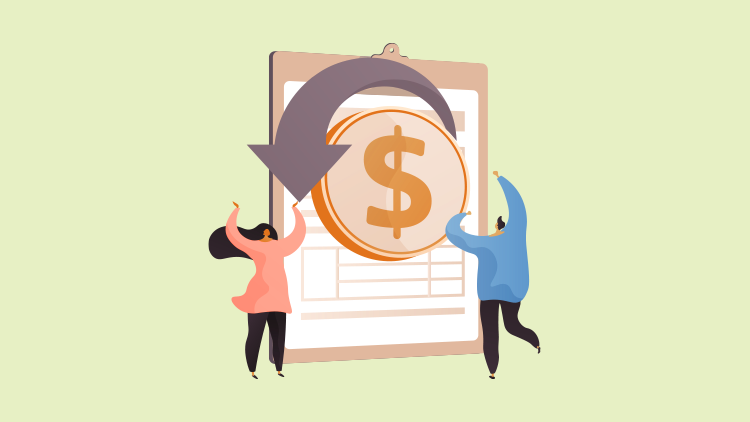by | Aug 6, 2021 | Tax Tips and News
Long-haul truckers now have an extra chore on their August to-do list, right up there with an oil change and a truck wash. It’s time to file Form 2290, Heavy Highway Vehicle Use Tax Return for Tax Year 2021.
Form 2290 is required of those who have registered—or who are required to register—large trucks, buses and other vehicles with a taxable gross weight of 55,000 pounds or more.
The deadline to file and pay for those vehicles on the road in July 2021 is Aug. 31.
For taxpayers who may be unsure if their vehicle qualifies, the Internal Revenue Service has their handy online tool, “Do I Need to Pay the Heavy Highway Vehicle Use Tax?”
The tool’s question-and-answer format helps owners determine if they owe the highway use tax. A recorded webinar, “Understanding Form 2290 – Heavy Highway Vehicle Use Tax” is also available.
What are some IRS tips for filing a highway use tax return?
Taxpayers will need some information handy before they start the filing process. They’ll need:
- An Employer Identification Number (EIN). Note that this is not a Social Security Number. If the taxpayer doesn’t already have an EIN, it could take up to four weeks to get one. How to Apply for an EIN has more information on the IRS website.
- The Vehicle Identification Number (VIN) and the taxable gross weight of each vehicle.
To file the Form 2290, e-file is the preferred method for sending it to the IRS; in fact, e-filing is required if the taxpayer is reporting 25 or more vehicles. Check out IRS.gov for a list of e-file providers approved by the IRS.
When the form is e-filed, the IRS sends the taxpayer a watermarked Schedule 1 just minutes after the electronic file is accepted.
If not sending Form 2290 via e-file, the taxpayer is left with sending a paper Form 2290 through the mail. Paper filers can expect a stamped Schedule 1 anywhere from one to six weeks after the IRS receives it. Taxpayers filing by mail will need the correct IRS mailing address, available on Tax Year 2021 Instructions for Form 2290.
Taxpayers, of course, will have to pay the Highway Use Tax when they file, and there are some options for this. The quickest and easiest way, many times, is through electronic funds withdrawal; this can be done as part of the e-file process.
The Electronic Federal Tax Payment System allows online payments, but requires enrollment ahead of the actual payment. Payment by credit or debit card is also available, as is paying with a Form 2290-V, Payment Voucher.
Vouchers should be mailed to:
Internal Revenue Service
P.O. Box 932500
Louisville, KY 40293-2500
Taxpayers should keep in mind that the filing deadline has nothing to do with the registration date of the vehicle. The IRS says taxpayers are required to file their Form 2290 by the last day of the month following the month the vehicle was first used on public highways during the taxable period.
The Trucking Tax Center on the IRS website has more information at IRS.gov/trucker. This site is also available in Spanish.
In addition, the Form 2290 Call Site is available for U.S. callers from 8 a.m. to 6 p.m. Eastern time at 866-699-4096 (toll-free). If calling from Canada or Mexico, call 859-320-3581 (NOT toll-free).
Help is also available through Frequently Asked Questions for Truckers Who e-File (also available in Spanish) and Frequently Asked Questions for Indian Tribal Governments Regarding Highway Use Tax.
Source: IR-2021-164
– Story provided by TaxingSubjects.com
by | Aug 5, 2021 | Tax Tips and News
Some IRS forms are considered “file and forget” documents, meaning once filed they normally don’t require any additional attention. The Internal Revenue Service, though, is reminding that the application for an Employer Identification Number (EIN) isn’t one of them.
The IRS says that those with an EIN—including businesses, partnerships, trusts and estates, charities and others—are required to update their EIN application with current information within 60 days of any change in the Responsible Party.
Keeping current isn’t difficult. Any changes to the EIN application may be made by filing Form 8822-B, Change of Address or Responsible Party – Business.
This information, the agency says, is critical should there be a question of identity theft or other fraud issues tied to the EIN or its parent organization. Wading through out-of-date information can waste valuable time.
“The data around the “responsible parties” for business-type entities is often outdated or incorrect, meaning that the IRS does not have accurate records of who to contact for identity theft issues. This means a time-consuming process to identify the point of contact so the IRS can inquire about a suspicious filing,” an IRS release states.
To increase awareness of the need for updates, the IRS is sending out letters to some 100,000 EIN holders who appear to have out-of-date responsible party information on file.
Current information is required
IRS regulations demand that all applications for an EIN have to show the name of the principal officer—the responsible party. This responsible party can be a general partner, grantor, owner or trustor.
The application also has to include the Taxpayer Identification Number of the responsible party, whether it’s a Social Security number, Individual Taxpayer Identification Number or an EIN.
The IRS defines the responsible party as the person who “controls, manages, or directs the applicant entity and the disposition of its funds and assets.”
The responsible party must be an individual, not an entity such as a board of directors, for example. If there are in fact more than one person who could be a responsible party, the applicant has to choose just one to appear on the EIN application.
If circumstances change and an organization no longer needs its EIN, the IRS says the organization should give up its Employer Identification Number. For information on shedding one’s EIN, see the IRS’ Canceling an EIN – Closing Your Account on the IRS website.
Source: IR-2021-161
– Story provided by TaxingSubjects.com
by | Aug 4, 2021 | Tax Tips and News
The Internal Revenue Service has updated its guidance on expanded paid sick and family leave tax credits available to employers who provide the leave to their workers. Put in place by the American Rescue Plan Act of 2021, also known as ARP, the credits permit eligible employers to be reimbursed for providing paid sick and family leave to their employees for COVID-19-related reasons.
The IRS has revised its frequently asked questions (FAQs) on the credits to clarify that eligible leave now includes that taken by employees to accompany a family member or another member of their household to get immunized against COVID-19, or to care for them as they recover from an immunization. This expanded eligibility is also extended to credits for self-employed taxpayers.
Coverage was extended by the American Rescue Plan.
The expansion of the paid leave tax credit is the latest improvement in an effort that started in 2020 with the Families First Coronavirus Response Act (FFCRA). While “the tax credits under the FFCRA, as amended and extended by the Tax Relief Act, covered leave taken beginning April 1, 2020, through March 31, 2021,” the IRS notes that ARP has further extended the credit to apply to leave taken from April 1, 2021 to September 30, 2021.
Additionally, under the American Rescue Plan, eligible employers include businesses and tax-exempt organizations that have fewer than 500 employees. Employers deemed eligible can claim tax credits for qualified leave wages and some wage-related expenses, including health plan expense and some benefits obtained through collective bargaining.
How do I learn more about the credit?
The newly expanded IRS FAQs explain how employers can claim the paid sick and family leave credits, as well as how to file for the credits and how to calculate applicable credit amounts. The FAQs also detail how employers can get advance payments or refunds of the credits.
The IRS closes the release by reminding self-employed taxpayers that they can “claim comparable credits on Form 1040, US Individual Income Tax Return.”
Source: IR-2021-160
– Story provided by TaxingSubjects.com
by | Jul 31, 2021 | Tax Tips and News
Tax professionals are a frequent target for identity thieves and cybercriminals, who are interested in accessing client tax records and, in some cases, the software used to file tax returns. The second week of the Security Summit’s “Protect Your Clients; Protect Yourself” campaign focuses on helping taxpayers protect their return by highlighting the benefits of an IP PIN.
The biggest hurdle is getting taxpayers to understand why they need an IP PIN and how they apply for one. While tax pros can’t complete the registration process for their clients, they can explain the benefits and process.
What is an IP PIN?
The IRS lists six tips for anyone considering an IP PIN:
- It’s a six-digit number known only to the taxpayer and the IRS.
- The opt-in program is voluntary.
- The IP PIN should be entered onto the electronic tax return when prompted by the software product or onto a paper return next to the signature line.
- The IP PIN is valid for one calendar year; taxpayers must obtain a new IP PIN each year.
- Only dependents who can verify their identities may obtain an IP PIN.
- IP PIN users should never share their number with anyone but the IRS and their trusted tax preparation provider. The IRS will never call, email or text a request for the IP PIN.
For late or extension filers, there’s still time to get an IP PIN for this year’s return. That said, those who have already filed but want to protect next year’s return will be able to apply for a PIN this coming January. Luckily, the IP PIN registration process is relatively straightforward for most taxpayers.
How do taxpayers sign up for an IP PIN?
The IRS says that those with secure Internet access should first consider the Get an IP PIN tool on IRS.gov. Users will need to have some personal information at hand when registering:
- Email address
- Social Security Number (SSN) or Individual Tax Identification Number (ITIN)
- Tax filing status and mailing address
- One financial account number linked to your name:
- Credit card – last 8 digits (no American Express, debit or corporate cards) or
- Student loan – (Enter the student loan account number provided on your statement. The account number may contain both numbers and letters. Do not include any symbols.) Additionally, we can’t verify student loans issued by Nelnet. or
- Mortgage or home equity loan or
- Home equity line of credit (HELOC) or
- Auto loan
- Mobile phone linked to your name (for faster registration) or ability to receive an activation code by mail
Since this info is required to verify online users’ identity, the agency suggests checking out the IRS.gov page detailing the Secure Access process: “Secure Access: How to Register for Certain Online Self-Help Tools.” Those preferring an analogue approach who make up to $72,000 a year can always file Form 15227, Application for an Identity Protection Personal Identification Number.
Here are a few more IP PIN-related links that taxpayers may find helpful:
Source: IR-2021-158
– Story provided by TaxingSubjects.com
by | Jul 30, 2021 | Tax Tips and News
The Internal Revenue Service says it’s not done issuing refunds for tax paid on COVID unemployment benefits. Another 1.5 million taxpayers are now slated to get refunds averaging over $1,600 as part of the IRS adjustment process in the wake of recent legislation.
It all started with passage of the American Rescue Plan Act of 2021, also called ARP, that excluded up to $10,200 in 2020 unemployment compensation from taxable income.
The exclusion was limited to individuals and married couples with modified gross income less than $150,000.
Refunds by direct deposit started in late July; paper check refunds start in early August.
So far, the IRS has gone through four rounds of refunds due to the unemployment compensation exclusion. So far, the IRS has issued nearly 9 million unemployment compensation refunds, totaling more than $10 billion. More, the IRS says, are on the way.
The IRS gets ahead of the curve.
The IRS says its efforts are focused on helping lessen the burden on taxpayers. The net result is most taxpayers won’t have to take any additional action to get a refund.
Most taxpayers impacted by the change in the law won’t have to file an amended return because the IRS has already reviewed their return and automatically adjusted the tax return for them. If a taxpayer overpaid, the agency either refunds the overpayment, or applies it to other outstanding taxes or other federal or state debts that are owed.
In this fourth round of refunds, the IRS says it found some 1.7 million taxpayers deserved an adjustment. Roughly 1.5 million of them are expected to get a refund, which are averaging around $1,600.
Processing has been on a sliding scale; simple returns were processed first, and more complex returns followed. In this fourth round of processing—part of the “more-complex” category, refunds are higher, because an adjustment to the Advance Premium Tax Credit or APTC was also included in the calculation.
To amend or not to amend, that’s the question …
In the vast majority of cases, the IRS says there’s no reason for taxpayers take any action or call the IRS. That said, there may be instances where taxpayers become eligible for deductions or credits because of the newly excluded income, tax breaks they weren’t eligible for prior to the IRS review.
If that’s the case, the IRS says those taxpayers need to file a Form 1040-X, Amended U.S. Individual Income Tax Return in order to claim those additional benefits.
These taxpayers should file amended returns:
There are other cases where the IRS considers an amended return to be the best course of action. These include:
- Taxpayers who did not submit a Schedule 8812 with the original return to claim the Additional Child Tax Credit and are now eligible for the credit after the unemployment compensation exclusion;
- Taxpayers who did not submit a Schedule EIC with the original return to claim the Earned Income Tax Credit (with qualifying dependents) and are now eligible for the credit after the unemployment compensation exclusion; or
- Taxpayers who find they are now eligible for other credits or deductions not mentioned here. They should make sure to include any required forms or schedules.
These taxpayers don’t need to file amended returns:
Conversely, these taxpayers do not need to amend their return. They include:
- Taxpayers who already filed a tax return and didn’t claim the unemployment exclusion; the IRS will figure the correct taxable amount of unemployment compensation and tax;
- Taxpayers who have an adjustment because of the exclusion, that will result in an increase in any non-refundable or refundable credits reported on the original return;
- Taxpayers who didn’t claim the following credits on their tax return but are now eligible when the unemployment exclusion is applied: Recovery Rebate Credit, Earned Income Credit with no qualifying dependents or the Advance Premium Tax Credit. The IRS will calculate the credit and include it in any overpayment;
- Taxpayers who filed a married-filing-joint return, live in a community property state, and entered a smaller exclusion amount than entitled on Schedule 1, line 8.
After the IRS makes an adjustment in a taxpayer’s return, the taxpayer gets a letter informing them that the adjustment was made and what kind of adjustment was made – whether they got a refund, or the adjustment went to pay a debt to the IRS or a payment offset for some other kind of authorized debt.
These letters, generally sent out within 30 days of the adjustment, also confirm the amount of the adjustment.
Source: IR-2021-159
– Story provided by TaxingSubjects.com
by | Jul 29, 2021 | Tax Tips and News
With summer comes the prospect of a summer job for college students. Many times, their top priorities are twofold:
- Get some valuable work experience that can help them snag a choice position once they’ve graduated
- Make some spending money while they’re at it
It’s during this time these working students get to know one of the basic laws of the Real World: Not all the money they earn goes into their pockets because their employer has to withhold taxes from their paychecks.
Even with part-time or temporary jobs, there are some things the IRS wants taxpayers to keep in mind.
What tax issues should college students consider when working a summer job?
New Employees: Workers, including students working summer jobs, normally have income and other taxes withheld from their paychecks by their employers. New hires need to fill out a Form W-4, Employee’s Withholding Allowance Certificate, and send that to their employer.
The employer, in turn, uses the completed W-4 to figure just how much money should be withheld from the new employee’s pay. In the old days, the employee had to figure out just how much to withhold from paychecks to satisfy the tax man. Now, though, new hires can go online and use the Withholding Estimator on the IRS website.
Self-Employment: If summer work consists of baby-sitting, lawn care or gig economy work and the like, these jobs are generally considered to be self-employed work by the IRS.
Cash earned from self-employment is taxable, and students in this line of work will have to pay their taxes directly to the Internal Revenue Service. One of the best ways to do this is to make estimated tax payments during the year.
Tip Income: Students who wait tables or tend bar as part of their summer jobs should remember that tip income is taxable. They need to keep a daily log of the tips they receive so they can report them accurately. Cash tips have to be reported to their employer if they bring in $20 or more for the month.
Payroll Taxes: These taxes pay for Social Security benefits. Even though students working a summer job might not earn enough over the season to owe income tax, their employers nevertheless have to withhold Social Security and Medicare taxes from their pay. Those students who are considered self-employed are generally responsible for paying Social Security and Medicare taxes directly.
Reserve Officers’ Training Corps Pay: Students in ROTC may be taxed on certain activities connected to their training. For example, if students are paid for things such as summer advanced camp, it is taxable. However, other perks the student receives, such as food and lodging, may not be taxed. See the Armed Forces Tax Guide on IRS.gov for more details.
For more information on summer jobs and taxes, check out Tax Rules for Students; Is My Tip Income Taxable?; and Do I Have Income Subject to Self-Employment Tax?
Source: IRS Tax Tip 2021-108
– Story provided by TaxingSubjects.com






